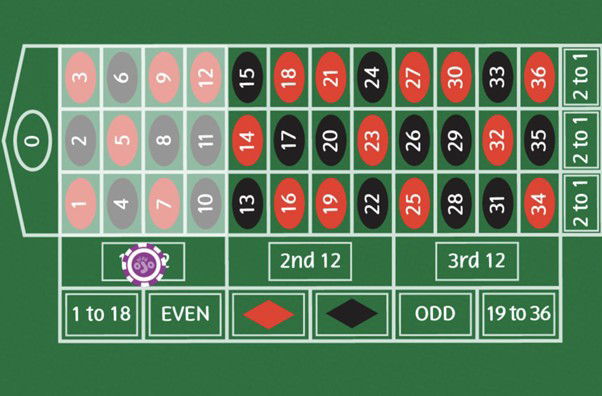The rules of roulette are simple, but the different variations of the game and the multitude of possible bets ensure countless strategies and decisions. Anyone who takes a closer look at the rules of roulette and the opportunities to win will quickly realise that there is much more to discover than meets the eye.
The basic rules of roulette
Roulette is a game of chance based on a spinning wheel divided into 37 or 38 slots. Most European casinos feature the classic ‘European Roulette’, which has 37 slots (including one zero). In the US, on the other hand, the 38-slot version is usually played, which has a double zero in addition to the single zero.
The basic rules of the game are clear: a dealer spins the wheel while players place their bets on the table. Bets can be placed on different numbers, colours or combinations of numbers and fields. When the ball lands on a field, winnings are paid out according to the roulette pay table.
The central question in every game of roulette is how the ball will start rolling and in which field it will end up. Players have the opportunity to place their bets on a variety of options that offer different odds and payouts. However, the rules always remain the same, regardless of the type of bet.
Roulette variants and their special features
If you want to play roulette, you should first have the different variants of roulette explained to you. Here is a brief insight:
European and American roulette
Ad
The most popular variants of the game are European and American roulette. In European roulette, there are 37 fields, including the numbers 1 to 36 and a single zero. This variant offers players a higher chance of winning because there is only one zero. American roulette, on the other hand, has a double zero in addition to the single zero, which increases the house edge for the casino slightly. Specifically, the house edge here is around 5.26%, while for European roulette it is around 2.7%.
European roulette has a lower house edge, which means that the odds are slightly better for the players. The payouts and betting options are identical, but the additional house edge in American roulette can reduce the player's long-term profit somewhat. If you're looking to make the most of your roulette experience, consider using stay casino free chip codes. These codes can give you a head start without requiring an initial deposit, allowing you to enjoy the game and explore various strategies while potentially boosting your winnings.
French roulette
French roulette is very similar to the European version, but differs in the rules and table layout. Particularly noteworthy is the so-called ‘La Partage’ rule, which refunds part of the players‘ bets when betting on even or odd numbers if the ball lands on zero. This rule can help to reduce the house edge and improve the players’ chances.
The layout of the table is also slightly different from European roulette, with certain boxes being combined, which changes the betting area. French roulette also often offers the option of combining certain bets, which opens up additional strategic options.
The different options in roulette
One of the aspects that makes the game so varied is the different types of wagers. These can be roughly divided into two categories: inside and outside.
Inside Wagers
Ad
Inside wagers refer to those placed directly on the numbers themselves or small groups of numbers. These offer higher payouts because the probability of the ball landing on a particular number is lower. Examples of inside wagers include:
● Straight Bet (directly on a number): The highest possible payout is 35:1. This option covers a single number, and the probability of winning is relatively low.
● Split Bet (between two adjacent numbers): This covers two adjacent numbers and offers a payout of 17:1.
● Street Bet (on a row of three numbers): This covers a horizontal row of three numbers and pays 11:1 odds.
Inside wagers offer high payouts, but the chances of winning are lower than for outside wagers.
Outside Wagers
Outside wagers cover larger fields and offer a higher probability of winning, but with lower payouts. Common outside options include:
● Red/Black (on the colour of the fields): This determines the colour of the number that will be drawn next, with a payout of 1:1.
Ad
● Even/Odd (on the parity of the number): A wager on even or odd numbers, also with a payout of 1:1.
● High/Low (on numbers 1-18 or 19-36): This covers a range of numbers and also pays 1:1.
Outside wagers offer a higher probability of winning, but the payouts are significantly lower, increasing the advantage to the player in terms of odds but not in terms of potential winnings.
Roulette Payout Chart: Understanding Payouts

The roulette payout chart shows how much a player can win in relation to their wager. Payouts vary depending on the type of bet and how difficult it is to win. Simple bets like red/black usually pay out 1:1, while the more difficult inside bets like a bet on a single number offer a payout of 35:1.
The roulette pay table is similar for each variation of the game, although there may be small differences depending on the casino or variation. A good understanding of this table is important in order to make targeted and strategic decisions. Familiarising yourself with the different stakes and payouts will help you to master the game and increase your chances of winning.
Strategies for playing roulette
Ad
There are numerous strategies used by players to improve their chances of winning. One of the most well-known is the Martingale strategy, in which the player doubles their bet after each losing round in an attempt to recoup losses from a single win at roulette. However, this strategy can quickly lead to high stakes, increasing the risk. In addition, many casinos set table limits that can restrict the application of this strategy.
Another popular strategy is the D'Alembert method, which involves reducing bets after each winning round and increasing them after each losing one. This method is considered less risky than the Martingale system because it does not aim to make up for losses by betting huge amounts.
Other strategies, such as the Labouchère or Fibonacci strategy, try to manage risk in different ways and offer players a structured approach to the game. But no matter which strategy is chosen, one thing always remains the same: the odds in roulette are determined by chance, and no strategy can predict the final outcome.





— تعليقات
0كن أول من يعلق